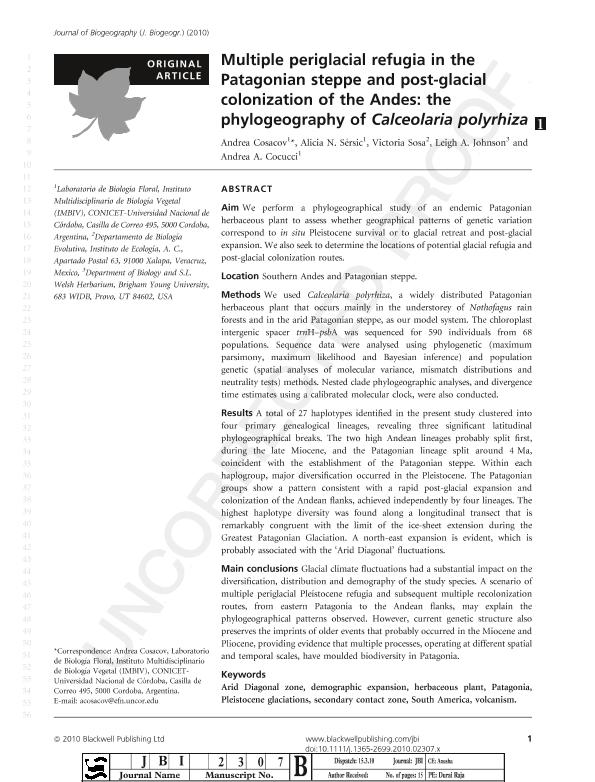Artículo
Multiple periglacial refugia in the Patagonian steppe and post-glacial colonization of the Andes: the phylogeography of Calceolaria polyrhiza
Cosacov Martinez, Andrea ; Sersic, Alicia Noemi
; Sersic, Alicia Noemi ; Sosa, Victoria; Johnson, Leigh A.; Cocucci, Andrea Aristides
; Sosa, Victoria; Johnson, Leigh A.; Cocucci, Andrea Aristides
 ; Sersic, Alicia Noemi
; Sersic, Alicia Noemi ; Sosa, Victoria; Johnson, Leigh A.; Cocucci, Andrea Aristides
; Sosa, Victoria; Johnson, Leigh A.; Cocucci, Andrea Aristides
Fecha de publicación:
09/2010
Editorial:
Wiley
Revista:
Journal Of Biogeography
ISSN:
0305-0270
e-ISSN:
1365-2699
Idioma:
Inglés
Tipo de recurso:
Artículo publicado
Clasificación temática:
Resumen
Aim We perform a phylogeographical study of an endemic Patagonian herbaceous plant to assess whether geographical patterns of genetic variation correspond to in situ Pleistocene survival or to glacial retreat and post-glacial expansion. We also seek to determine the locations of potential glacial refugia and post-glacial colonization routes.
Location Southern Andes and Patagonian steppe.
Methods We used Calceolaria polyrhiza, a widely distributed Patagonian herbaceous plant that occurs mainly in the understorey of Nothofagus rain forests and in the arid Patagonian steppe, as our model system. The chloroplast intergenic spacer trnH–psbA was sequenced for 590 individuals from 68 populations. Sequence data were analysed using phylogenetic (maximum parsimony, maximum likelihood and Bayesian inference) and population genetic (spatial analyses of molecular variance, mismatch distributions and neutrality tests) methods. Nested clade phylogeographic analyses, and divergence time estimates using a calibrated molecular clock, were also conducted.
Results A total of 27 haplotypes identified in the present study clustered into four primary genealogical lineages, revealing three significant latitudinal phylogeographical breaks. The two high Andean lineages probably split first, during the late Miocene, and the Patagonian lineage split around 4 Ma, coincident with the establishment of the Patagonian steppe. Within each haplogroup, major diversification occurred in the Pleistocene. The Patagonian groups show a pattern consistent with a rapid post-glacial expansion and colonization of the Andean flanks, achieved independently by four lineages. The highest haplotype diversity was found along a longitudinal transect that is remarkably congruent with the limit of the ice-sheet extension during the Greatest Patagonian Glaciation. A north-east expansion is evident, which is probably associated with the ‘Arid Diagonal’ fluctuations.
Main conclusions Glacial climate fluctuations had a substantial impact on the diversification, distribution and demography of the study species. A scenario of multiple periglacial Pleistocene refugia and subsequent multiple recolonization routes, from eastern Patagonia to the Andean flanks, may explain the phylogeographical patterns observed. However, current genetic structure also preserves the imprints of older events that probably occurred in the Miocene and Pliocene, providing evidence that multiple processes, operating at different spatial and temporal scales, have moulded biodiversity in Patagonia.
Archivos asociados
Licencia
Identificadores
Colecciones
Articulos(IMBIV)
Articulos de INST.MULTIDISCIPL.DE BIOLOGIA VEGETAL (P)
Articulos de INST.MULTIDISCIPL.DE BIOLOGIA VEGETAL (P)
Citación
Cosacov Martinez, Andrea; Sersic, Alicia Noemi; Sosa, Victoria; Johnson, Leigh A.; Cocucci, Andrea Aristides; Multiple periglacial refugia in the Patagonian steppe and post-glacial colonization of the Andes: the phylogeography of Calceolaria polyrhiza; Wiley; Journal Of Biogeography; 37; 8; 9-2010; 1463-1477
Compartir
Altmétricas



